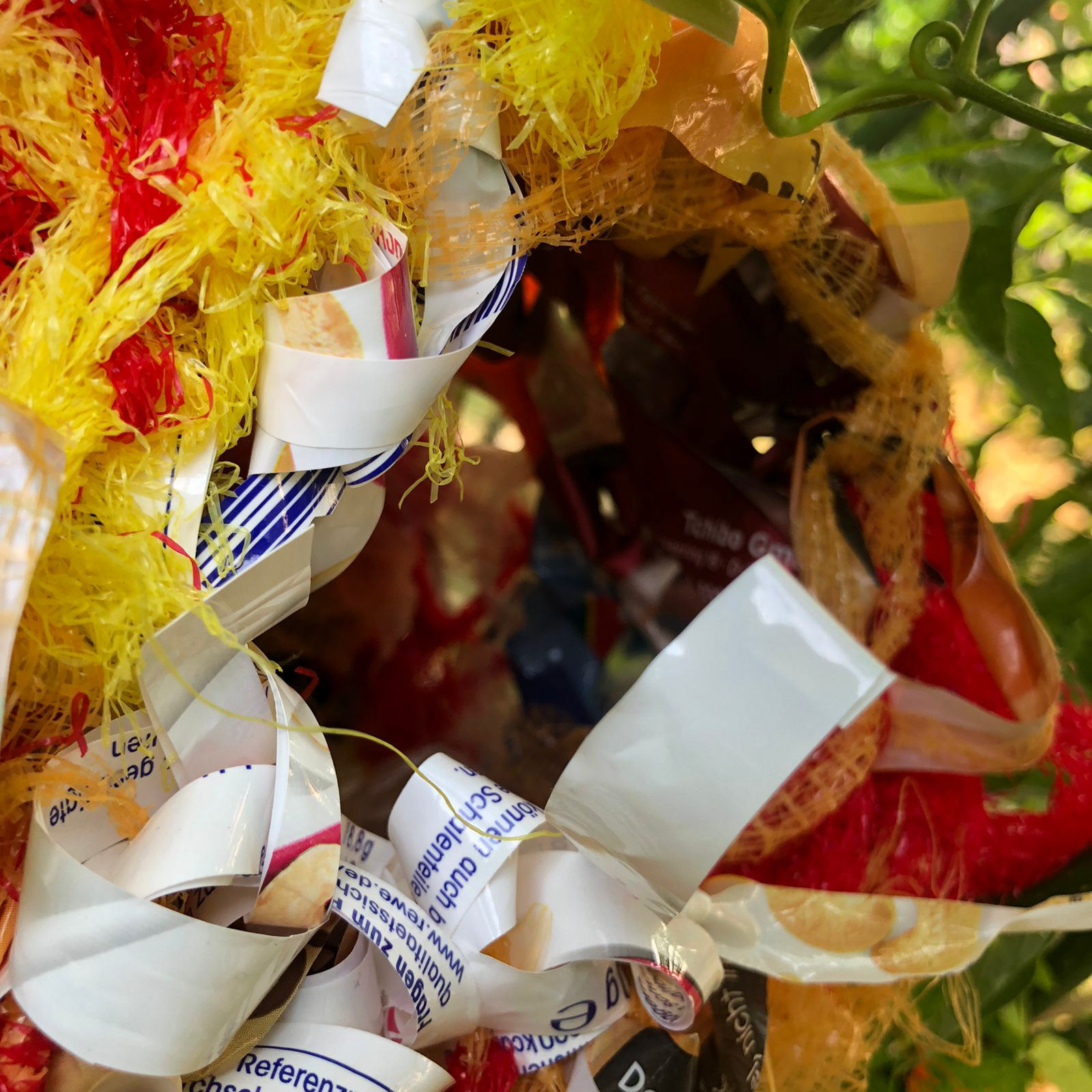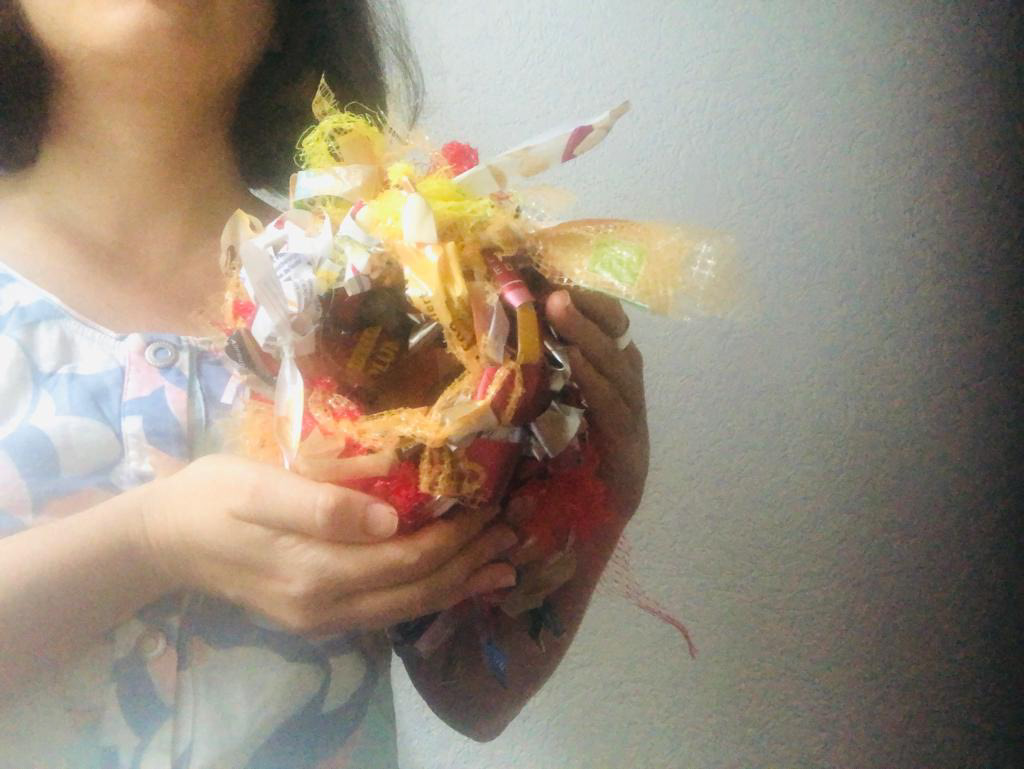


Can we build a nest?
Tissue and photos
Plastic waste thread tissue.
Framed in the course Media technologies 3 at Open Design Master. Universidad de Buenos Aires, Argentina y Humboldt University, Germany.
Berlin, Germany, 2022
Expanded version_
My mother planted pumpkins and made compost, my father taught me how to tie worms on small hooks to fish in front of the house, my aunt brought nuts from the island and my grandmother prepared fish to cook on the fire. Since I was a kid I learnt the abundance of nature, and as an adult I learnt the abundance of society, we produce too much, and we discard everything, sooner or later. I used to make wishes to the street and the street used to give them to me: I need containers for my roof orchard -I said- and the street would give me a pile of buckets.
Since I was young, years accelerated and in my short lifetime I saw the destruction of my home landscape. In my twenties I was already betrayed by the local authorities that would not control river pollution. I gave up on my environmental activism. I know there's not enough planet earth for materializing our future consumption desires if as society we do not rethink and redesign our lives in a more sustainable way in which every human being can access the most escentials needs. Who can I partner with? Who or what. And when. Can I still save the world?
The limits between nature and human beings can be discussed. Do we belong to nature? If we do, is it enough to know that we belong? Can we feel that belonging? Once we realize we are nature and nature is us, can we live in an instinctive-rational-social less distructive way?
Plastic derives from oil, oil that is squeezed from depths of our ground, that have been covered for hundreds of years of sedimentation and movement flows of other materials and elements. Oil has been developed by humans for years to make fuel and plastic. To make energy a fake infinite resource. We learnt to use it, we did not learnt to manage it. Iron and concrete derive from minerals extracted from the ground processed by low income workers.
We seem to be every day more dependent on technology and more separated from the ground, but we are still connected to the Big Bang: “we carry small pieces of Africa in our pockets” Benjamin Bratton’s words are quoted by Jussi Parikka “referring to the role, for instance, of coltan in digital media technologies” in an amazing review of the relation between geology and media (Parikka, Geology of Media, 46). Life has been about photosynthesis, sediment, decay, cell reproduction and feed-chains developing at every scale all around the universe: “humankind had relied on energy captured from ongoing flows in the form of wind, water, plants, and animals, and from the 100-or 200- year stocks held in trees. ” (Steffen et al., The Anthropocene” 616)
There's no doubt of the impact of those complex materials in the geosphere, in animals, in the pollution of water bodies, but, why are we considering these pollution materials as separated from planet earth? Is it about biodegradability? Is it about life time? Is it about permeability?
On a micro scale, some day in the future every material will be degraded, but what about our life nowadays? Where are we choosing to live our lives? It seems that blaming the human beings for the destruction of their/our – own – livelihoods is not making the effect needed to change the trajectory of our behavior. In words of Jane Bennett in her book Vibrant Matter, we should practice a different approach to nonhuman elements to experience a different closeness: “We need to cultivate a bit of anthropomorphism-the idea that human agency has some echoes in nonhuman-to counter the narcissism of human in charge of the world”. This exercise may change the engagement with matter and be the key for a solution to our destructive present. The mentioned author argues that the disconnection with inanimate matter may be one of the facts that impossibilitates the emergence of more ecological conceptions of our life and its impact in the Earth and following that idea, an engagement with non-natural things can make us more sensible to natural things: “The figure of an intrinsically inanimate matter may be one of the impediments to the emergence of more ecological and more sustainable modes of production and consumption.” (Bennett, Vibrant Matter, ix)
“…is no longer possible to maintain the dualism between nature and culture in its existing form” claims the catalog of the current exhibition at Haus der Kulturen der Welt in Berlin that asks ´to open up new approaches of the world´. The exhibition shows scientific studies of the group in charge of collecting samples to declare the existence of the Anthropocene as a geological era. We, humans, are a result of nature developing itself through evolution. At some point, that development led us to an anthropocentric perspective that disconnected us from nature, the ground, the earth and the universe.
I would say then, that the key factor is time, we are transforming planet Earth faster than it can restore to a healthy environment we will be able to live in: “the Anthropocene (...) starts to crystallize as a systematic relation to the carboniferous: the layers of photosynthesis that gradually were being used for heating and then as energy sources for manufacture in the form of fossil fuels.” (Parikka, Geology of Media (17)
How long does it take a bird to build a nest? I had the pleasure to see some birds building a nest in my garden. Day by day, those very small beings flew around the house collecting precious materials to build the shelter for their future pigeons: an assembly of different fibers such as feathers, sticks, the most thin brunches, stems, leaves, my pets and my oun human hair. It was a patient job, as patient as the work of an artisan harvesting rush of willow to build a basket.
Writing this essay has been difficult for me. I do not feel comfortable sharing statements or definitive affirmations. My capacity of understanding is starting to feel saturated and on the other hand, I am quite sure about only one thing and everything else is doubtful. I am sure about nature as our source of life and I am not sure about the necessity of discovering and understanding every natural phenomena.
I can live without understanding the magician's tricks. I would say it can be the nonhuman turn, the lever arm for de-anthropo centering our future. How long does it take for a tree to grow and to a river to sediment toxins in the river bed or to a wetland to filter tide water? Can we be as patient as the tree and the bird? Can we build a nest?
References
Jane Bennett, Vibrant Matter (United States: Duke University Press, 2010).
“Curatorial Statement”, Earth Indices, Haus der Kulturen der Welt, https://www.hkw.de/en/programm/projekte/2022/earth_indices/kuratorisches_statement_earth_indices/text.php
Jussi Parikka, Geology of Media (Minnesota: University of Minnesota Press, 2015), chap 2, http://ebookcentral.proquest.com/lib/huberlin-ebooks/detail.action?docID=1983521